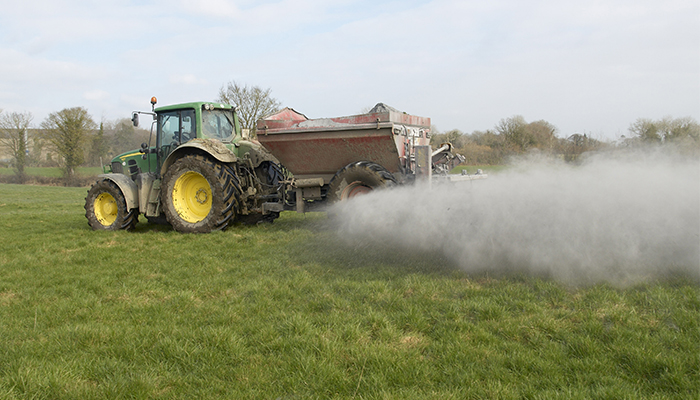10 April 2023
An opportunity to apply the ‘forgotten fertiliser’ in 2023

Exponential increases in the cost of farm inputs in recent times have placed farmers under a lot of pressure. With this, it has never been as important for farmers to try and maximise efficiency on the ground.
Fertiliser is a core component, but also a significant cost on many farms. Damien Gibbons, Walsh Scholar, Teagasc Ballinrobe, tells us how input levels can be reduced through a targeted liming approach.
The benefits of liming have been known for years. Unfortunately, lime has been the forgotten fertiliser on many farms. Lime is a cost-effective natural soil conditioner, which neutralises soil acidity, increases the activity of soil microbes (e.g. earthworms) and most notably increases the availability of soil phosphorus (P) reserves. Combined, this leads to improved yields from grass and crops, which is a win for all farming enterprises irrespective of scale.
Acidic soils that are lacking lime will not respond optimally to applied fertilisers. Soils that have sufficient liming levels (pH 6.3-6.5 for mineral soils) will give rise to full utilisation of applied fertilisers (straights or compounds) for grass and crop growth, ensuring farmers get better value for their money. Liming can release up to 80kg N/ha/year and can increase overall grass production by up to 2.0t DM/ha. It is very inexpensive (approx. €25-30/tonne delivered and spread) when compared to artificial fertilisers.
Application rates are determined by soil analysis reports. If the lime requirement is greater than 7.5t/ha or 3t/ac, it should be split into two dressings. Note, it is now too late to apply lime to silage fields. Instead lime these fields after silage is cut. In order to minimise nitrogen losses, slurry and urea need to be applied at least 7-10 days prior to an application of lime.
National Liming Programme 2023
The Department of Agriculture, Food and the Marine (DAFM) recently launched an €8 million National Liming Programme. The main aim of the programme is to incentivise farmers to apply ground limestone in order to maintain soil fertility. While lime application has increased over the last two years, results from the Teagasc National Soil Fertility Report in 2022 indicated that 57% of drystock soils still have a liming requirement. With this in mind, it would be advisable for all eligible farmers to consider applying for the scheme as there is a financial contribution of €16/t available for successful applicants for any lime applied in 2023. Like all schemes, there are a few key requirements in order to avail of this subsidy, including:
- Applications are to be made on AgFood either by the farmer or his/her advisor – indicating the intended quantity to purchase and spread.
- Lime can only be purchased from licenced quarries approved by the DAFM – list of quarries can be seen on DAFM website.
- Minimum of 10t and maximum of 200t to be subsidised.
- Lime cannot be spread on the following: commonages; forestry; Natura 2000 designated lands (SAC, SPA, NHA); Annex 1 grassland; or environmentally sensitive permanent grassland.
- Applicants must have a submitted a 2022 BPS application and a 2023 BISS application.
- Applicants must have up to date soil analysis reports indicating there is a liming requirement on the farm and application rates are to follow the recommendations in the soil analysis report;
- Closing date for applications is 20th April 2023 and claims for payment (submission of invoices) must be made by 31st October 2023.
While most farmers will be able to apply, unfortunately some farmers will not be eligible for the following reasons:
- Farmers that availed of a Nitrates Derogation in 2022 or 2023 and farmers with a grassland stocking rate above 170kg livestock manure nitrogen/ha prior to export in 2022;
- Herdowners who are participating in the 2023 Eco-Scheme practice relating to soil sampling and liming.
The National Liming Programme is an attractive initiative, which should be considered by farmers. The benefits that ensue from liming are significant and when there is a subsidy available it makes it all the more attractive. If you require any further information on the programme or liming contact your local Teagasc office.
Also read: Caution advised as soil fertility levels remain stable in 2022
